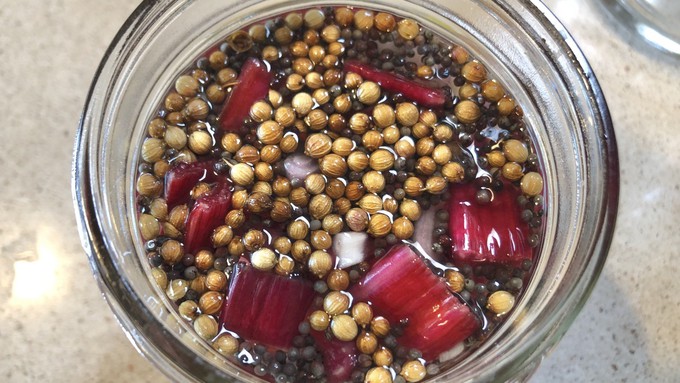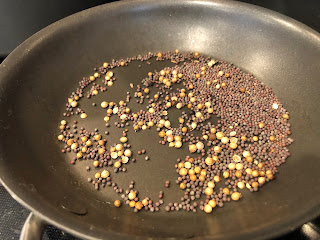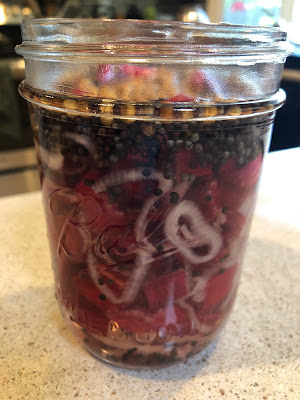
Recipe: Rainbow chard stalks produce a pretty snack

Red chard stems and spices are covered in brine, ready to chill in the refrigerator. Kathy Morrison
In my continued quest to not let anything go to waste these shelter-at-home days, I went hunting for recipes to use chard stalks. There had to be something out there that used the long, pretty, celery-like stems from my never-say-die chard plant .
I hit on pickles, and have tried a couple of recipes now. The one here (adapted from an Epicurious recipe) is my favorite so far, with mustard seeds, coriander seeds and a shallot -- adding a lot of flavor to the gorgeous but rather bland chard stalk pieces.
These pickles aren't as fast as our blog's famous Zapped Pickles , but they still go together pretty quickly. No canning is involved, since they pop into the refrigerator, but make sure to have a sterilized pint jar ready to put them in. (The dishwasher works just fine.) Then chill and enjoy!
Refrigerator chard stem pickles
 |
|
A few ingredients are all you need to make a pint of pickles.
|
Makes 1 pint
Ingredients:
4 large stalks from chard, washed and trimmed
1 small shallot, thinly sliced
2 tablespoons kosher salt
1 tablespoon brown mustard seeds
1/2 tablespoon coriander seeds or caraway seeds
A couple of black peppercorns, optional
Brine:
1/2 cup unseasoned rice vinegar (champagne vinegar, apple cider vinegar or white wine vinegar also work, but avoid distilled white vinegar)
1/4 cup granulated sugar
1/2 cup water
Instructions :
 |
| Toast the seeds before using in the pickles. |
Slice the chard stems into 1/2-inch pieces, removing any outer strings that come loose as you cut. You should have about 2 cups of pieces. Combine the chard pieces with the shallot slices and the salt in a colander set in the sink or over a large bowl. Let stand 1 hour.
About 15 minutes before the chard stems are ready, toast the mustard seeds and coriander seeds (and peppercorns, if using) in a small, dry skillet over medium heat. Stir often. In about 2 minutes, the mustard seeds will start to pop open. Remove the pan from the heat before too many pop, and let the seeds cool.
To make the brine, combine the vinegar, sugar and water in a small saucepan, and bring to a boil. The sugar should dissolve quickly. Remove pan from heat.
 |
|
After cooling the brine-covered pickles for a few minutes,
cover them and refrigerate overnight.
|
Rinse the chard stems/shallot combination well, and drain well. Pack the stems, shallots and cooled seeds in a sterilized (washed in hot soapy water or in dishwasher) pint jar. Pour the brine into the jar over the vegetables. Let the mixture cool slightly, then cover the jar with a tight-fitting lid and place it in refrigerator. Chill overnight before serving. Gently shake the jar occasionally, if you think of it, but that's not a must.
The pickles will keep in the refrigerator about a month. If you used red chard stems, the lovely color will fade eventually, but the pickles likely will be consumed before that happens.
Comments
0 comments have been posted.Sacramento Digs Gardening to your inbox.
Sites We Like
Garden Checklist for week of April 21
This week there’s plenty to keep gardeners busy. With no rain in the immediate forecast, remember to irrigate any new transplants.
* Weed, weed, weed! Get them before they flower and go to seed.
* April is the last chance to plant citrus trees such as dwarf orange, lemon and kumquat. These trees also look good in landscaping and provide fresh fruit in winter.
* Smell orange blossoms? Feed citrus trees with a low dose of balanced fertilizer (such as 10-10-10) during bloom to help set fruit. Keep an eye out for ants.
* Apply slow-release fertilizer to the lawn.
* Thoroughly clean debris from the bottom of outdoor ponds or fountains.
* Spring brings a flush of rapid growth, and that means your garden is really hungry. Feed shrubs and trees with a slow-release fertilizer. Or mulch with a 1-inch layer of compost.
* Azaleas and camellias looking a little yellow? If leaves are turning yellow between the veins, give them a boost with chelated iron.
* Trim dead flowers but not leaves from spring-flowering bulbs such as daffodils and tulips. Those leaves gather energy to create next year's flowers. Also, give the bulbs a fertilizer boost after bloom.
* Pinch chrysanthemums back to 12 inches for fall flowers. Cut old stems to the ground.
* Mulch around plants to conserve moisture and control weeds.
* From seed, plant beans, beets, cantaloupes, carrots, corn, cucumbers, melons, radishes and squash.
* Plant onion sets.
* In the flower garden, plant seeds for asters, cosmos, celosia, marigolds, salvia, sunflowers and zinnias.
* Transplant petunias, zinnias, geraniums and other summer bloomers.
* Plant perennials and dahlia tubers for summer bloom.
* Mid to late April is about the last chance to plant summer bulbs, such as gladiolus and tuberous begonias.
* Transplant lettuce seedlings. Choose varieties that mature quickly such as loose leaf.